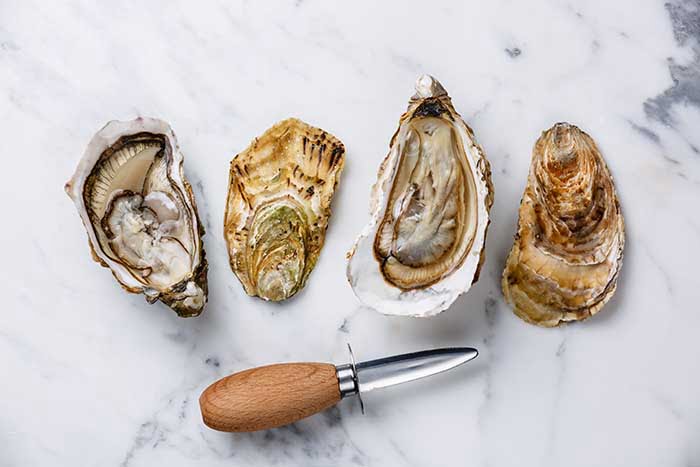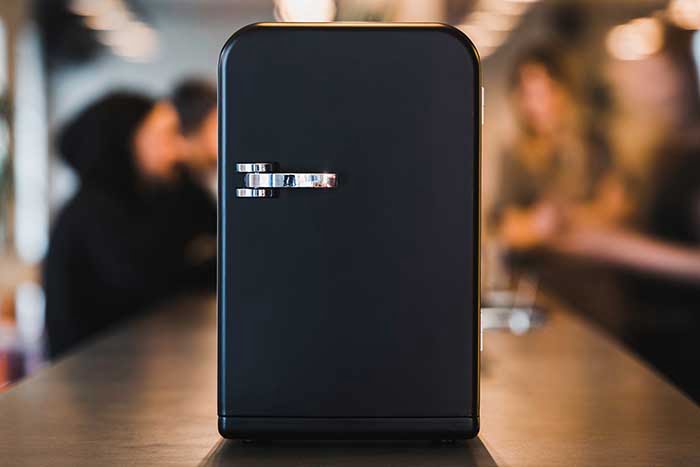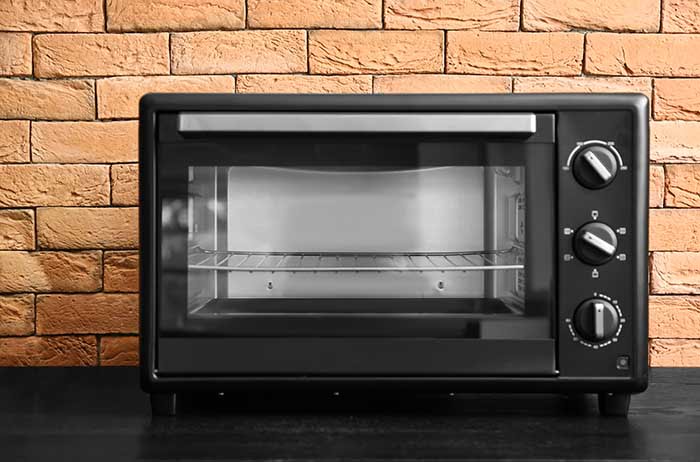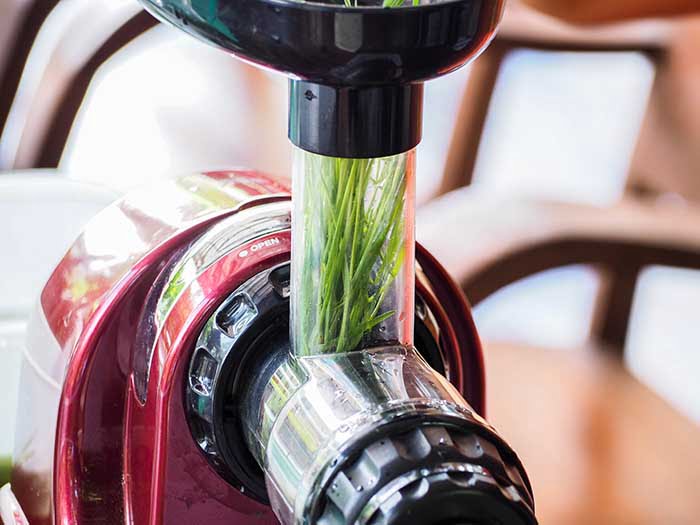Oysters are the perfect hors d’oeuvre: Cold and briny with the fresh, salty-air scent of the ocean. Paired with a crisp white wine or Champagne, they are a thing of beauty.

To get the most out of them, you’ll need the best oyster knife; a special dull-pointed, thick-bladed knife that is used to pry the back hinge open and separate the body from the shell.
A good oyster knife is one that allows you to probe and pry, rather than cut or slice into anything. So a sharp-edged knife is not what we really need here. Rather, something that allows you good purchase and leverage against the most stubborn of oysters.
Victoirnox 2 3/4 Inch Hook Tip
The very reasonably priced Victorinox is sturdy and has a great grip that feels both comfortable and strong.
Grip is just as important as blade when it comes to oyster knives, and nowhere is this more apparent than with the Victorinox. It has a slip-free grip that means that even when wet, the knife will stay firmly set in your palm.
- Made of highest quality Swiss and Victorinox materials
- Kitchen Specialty Knives & Tools Oyster 2¾" Blade, New Haven Style, Bent Tip, SuperGrip Red
- Innovative and durable
Hicoup Oyster Knife
This beautiful tool from Hicoup is wonderfully crafted as well as sturdy. It doesn’t compromise on resilience however, and is more than up to task when it comes to shucking hundreds of oysters.
It’s thick and strong, giving you no trouble when you need to get stuck in.
- HIGH CARBON BLADE - Our artisanal oyster shucker features a blade forged with mirror-finish...
- SAFETY - The pakka handle of this oyster opener boasts a handguard to keep wet hands from slipping...
- TOP NOTCH DURABILITY - Measuring 6.5" from tip-to-tip with a 2.5" blade, our professional-grade...
Wusthof Classic
This Wusthof oyster tool is a strong beast. Its shape makes it great for approaching side-on as well as the hinge, and its surface is non-scratch. This knife is built to last and absolutely worth the added expense.
- Durable riveted handle oyster knife
- Synthetic handles are compression riveted to the full tang of the blade
- Laser cut from High Carbon German "X50CrMoV15" No Stain steel
Melocean Shucking Knife Set
At the other end of the price scale is this tool by Melocean. Like the very best, it has anti-slip grip and and an angled tip.
What might put you off? It’s a long blade at nearly 4 inches, which doesn’t make it the easiest to use. And its grip is perhaps not the most comfortable.
- Strong & sturdy solid steel blades. Forged from the top quality 3cr13 stainless steel &...
- Ergonomic all wood knife handles. Carved from solid wood & polished to prevent slipping, each 6.3...
- Bonus oyster opener guide & ebook. Every order includes a comprehensive oyster shucking knife...
WENDOM Shucker Set
Rounding off our list is this model from Charleston. Its blade appearance is beautiful, making it a wonderful gift for oyster newcomers. It has a steel guard to protect your hand, and its blade is one of the strongest we’ve ever seen. A must have.
- 【AWAY FROM HURT】Gloves made of Highest Cut Resistance Level Material on the market. Thick knife...
- 【STRONG&STURDY BLADES】Forged from top quality 3CR13 Stainless Steel&Professionally Sharpened,not...
- 【NON-SLIP DESIGN】WENDOM knife made of black plastic handle,soft and comfortable to grip,won't...
What is an oyster knife?
Oysters can be pretty difficult to open if you do not know how to. This is why many people feel they need a tutorial when it comes to eating oysters. You can’t use just any knife to pry them open. Otherwise, all the goodness stays inside, and there’s no getting around it.
A good oyster knife needs to have certain qualities that make them unique and effective. There are different sizes of knives, and they are made to open different shapes and sizes of oysters. They differ in blade size. The blade needs to be sharp enough to do the job, beveled, thin, and pointy enough to slide in between the shell and get the meat out. The handle needs to be strong and comfortable to hold.
A shucking knife cannot be replaced by a knife with an entirely rounded front, as the pointy tip is what you will need to poke through the hard shell. There isn’t much space to work with, as you would have almost to pry like you’re picking a lock.
Don’t be tempted to use a butter knife, or a screwdriver, or a tool that may seem like it would do the job like a letter opener. The blades and handles on oyster knives are specially made to ensure your safety as you work on the shell that is often very hard. Therefore some replacements may not have the required durability.
Oyster Knife Styles
New Haven Style
It has a unique blade that curves upwards, and it is also short and wide. It’s a short blade, makingnot winding it easy to pry open hard shells without breaking them—the tip, which points upward, which sets this knife apart from others.
The handle is comfortable to hold and will allow you to hold the knife in a tight grip for long periods. It is made of hardwood and polypropylene and is lightweight. It works well to open up oysters on the half shell and remove the meat clean off the shell.
Boston Style
This knife has a long and narrow blade. It has a forward bulge on the handle, which also lets you rest your thumb on it. The blade is a bit convex, but it is also blunt. The tip is not pointy; instead, the blade narrows towards an almost rounded tip. It’s a good option for shucking oysters. You can use it for just about any oysters.
Galveston Style
This knife has a long blade, which works well for large oysters. As such, they are great for commercial use. The blade is flat and moderately sharp, with a rounded tip. The handle is pear-shaped and comfortable to hold. The length of the blade sets it apart from other knives.
Features
Blade
The blade on an oyster knife needs to be sharp enough to pry the shells open. This does not mean that it needs to be super pointy as a prerequisite. Just sharp enough to pry through the shell. Make sure that it is made of material that is corrosion resistant and that it is made of durable material. Oyster shells are tough, so the blade needs to be as well.
Durable blades are mostly made for high carbon steel and stainless steel. These materials do not rust much. However, carbon steel is more likely to corrode. The least corrosive blade is best so that the saltwater from the oysters doesn’t corrode the blade. The best material for the blade is Ferritic stainless steel 440c. Make sure to look for a blade that is about 3 inches long. If the blade is too long, it can puncture the meat.
Grip
Look for a knife with a good grip so that you do not hurt yourself as you apply pressure to open the oyster. Also, make sure that it is comfortable enough and will not slip. Rounded handles with a rubber grip help keep the knife non-slip. Make sure the grip allows you to wrap your fingers around the handle of the knife. Remember that your hands will probably have a certain amount of moisture when you hold the oysters, so you don’t want a slippery surface on the handle.
Knife guard
A knife guard is meant to help keep your fingers safe. It keeps the blade and fingers in separate spaces. The issue with these is that they can feel cumbersome and get in the way, especially when the oysters are small. You can use protective gloves in place of these.
Stainless steel
Oysters contain a lot of natural salt which can be incredibly corrosive on metal, so to combat this we need a material that is resistant to even the harshest of salt bodies. Stainless steel is your friend. Look out for any knife featuring 420hc. It’s one of the most corrosion resistant stainless steels available, so it’s no surprise to see it featured in a lot of professional kitchen knives.
Blade length
We’re looking for something light and easy to use, but strong at the same time. Long blades will be prone to bending or snapping, so aim to look for anything under 3 inches long.
New Haven Tip
Not only do we need a short and resilient blade, but we need one especially designed for prying oysters out of their shell. Meet the New Haven Tip. It’s a special blade tip that is upturned to help you pry even the most stubborn oysters out of their shell while also retaining their natural shape.
Weight
As mentioned with choosing a good grip, the weight of your knife also needs to suit you. Shucking oysters can be a lengthy process, so you need something that you will be comfortable using for extended periods of time. Shucking oysters should be fun, not tedious.
How to use an oyster knife
How to sharpen an oyster knife
You can sharpen an oyster knife by running it across rough concrete. You can also use a regular sharpener to restore the blade’s glory.
How to use an oyster knife to open oysters
To open an oyster using a shucking knife, locate the hinge. Do this by putting the tip of the knife into the hinge, which seemingly holds the two faces of the oyster together. Then make sure that about a third of the tip is in before you begin to pry it open. This is often referred to as the keyhole method. Some prefer to open from the right side and then slide the knife across to cut the muscle.
How to use an oyster knife to shuck oysters
Set the oyster on a towel, with the flat side down. Then push the knife into the hinge, then slip the knife’s blade down as you jimmy across it, making sure to keep the knife close to the top of the shell, which helps loosen and cut the muscle.
Best way to clean an oyster knife
The best way to keep your knife clean is to wash it by hand. Use warm water and soap, for efficiency, after every use. You also want to make sure that you properly dry it after use to not wind up with leftover dirt on it, which could encourage corrosion.
FAQs
Can you shuck oysters with a regular knife?
It’s not advisable, as the blade and handle are not strong enough and could puncture the meat or crack the shell.
What is the difference between clam knives and oyster knives?
Clam knives are usually thin and flat, while oyster knives can be slightly wider and have a curved tip or a pointed tip.
Should an oyster knife be sharp?
It should be sharp enough to wedge the shell open but not too sharp that it becomes dangerous as you apply pressure to open the shell.







